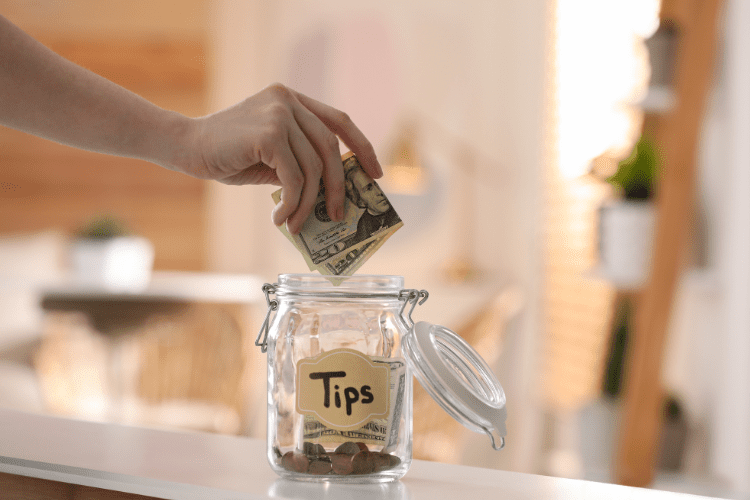Has Tipping Culture Gone Too Far?

Who doesn’t mind leaving a good tip for great service? This has been customary etiquette in the restaurant and hospitality industry for years. But of late, it’s more than just the restaurant and hospitality industries with expectations of a good tip. No matter where you turn to get a service or product, the onus is on you to leave a tip, even for services where it doesn’t make much sense.
If you walk into a coffee shop, spend money on a cup of coffee, pay for it, and take it yourself without any interference from another employee, do you feel compelled to leave a tip? According to today’s tipping standards, leaving a tip would be right. How about when you pay for an oil change? Do you think you should have to leave the mechanic a tip – for doing what you’re already paying the mechanic to do? Don’t they apply labor charges to such services?
Let’s look at where tipping started and where it is now to determine if tipping is currently out of control.
How Tipping Started
The practice of tipping started during the medieval times in England, but the act of tipping was not meant for everyone. Servants would receive tips from their employers if they performed extremely well.
In the mid-1800s, Americans began doing this, but still, it wasn’t meant for everyone to do so. Tipping was done by those with higher social status since they had the most money and could afford to tip.
Where Tipping Is Today
Today, tipping has come a long way from where it initially started. Any industry can get in on this, and many of them have. Tip creeping is a term that refers to other businesses (outside of the initial industries) that are now feeling compelled to be tipped – by anyone. Whether it’s a mechanic shop, a retail store, or a grocery store, employers everywhere are expecting customers to tip their employees. Some businesses are less subtle but have made it a point to leave a tip jar near their register to entice you to give more – even after you’ve already paid.
This does not always make sense. Taking the example of the mechanic from above – labor cost is already included in the cost of your expensive oil change, so why should the mechanic be tipped?
Here’s another example to consider: if you use a self-service checkout or kiosk (which most industries now utilize) and pay for an item, should you have to tip? According to most self-checkout registers, a tipping screen pops up, and the option to leave a tip is made available. But, who would the tip even go to if you had zero employee interaction and put yourself to work at the checkout register? A better question might be, who will pay you to ring up and bag your items, as you’re now performing as an employee? While this may be a little humorous, the reality is that tips are expected even if they aren’t warranted.
How Much Is a Tip?
Remember when a generous tip meant leaving 10% of the bill to the person who waited on you? Ten percent had been the norm for a while – since the 1950’s. As everything in society eventually increases, it’s no surprise that the tip rate also increases. During the 1970s and 1980s, the normal tip increased to 15%. Before the pandemic, tips had increased to 20% of the bill. As of today, people will tip up to 30%. How did that happen?
With people seeing that the most pressure from the pandemic was on the hospitality industry, people were willing to tip a little more to help in any way they could. As a result of the pandemic, service in some industries had to change to accommodate the special circumstances. More people were getting food delivered to their homes, and curbside service was also introduced. So, people were getting additional services without having to do much themselves, from having food brought to wherever they were parked to having someone shop groceries for them and then hand deliver. For these extra perks, people didn’t mind tipping 25% or 30%.
But now, even though the need for those types of services has decreased, businesses are still seeking high tip rates, even if they’re not deserved. In addition, many restaurants have now incorporated a service charge with the final bill. This isn’t a charge attached to the menu. Nor is it a tip. It’s a charge they decided is needed to help pay the workers behind the scenes you may never see, like the cooks, dishwashers, and others. Keep in mind these are the employers’ employees. The tip is expected in addition to the service charge.
Let’s remember how tipping started – from overperformance. And also, remember, this started with employers paying their deserving employees additional with a tip.
With more businesses in the service industry applying self-service options and still asking for tips, it questions the need for tips – especially if there’s no human service involved.
In addition to that, service workers no longer feel a need to overperform because tipping is what the customer is expected to do – regardless of their social status.
The Bottom Line
As many others in the world today, you may also feel that our tipping culture has gotten out of control. Is the answer to stop tipping? I would say absolutely not – especially when it comes to the hospitality industry. For all other industries, I’ll let you be the judge.
One word of advice when it comes to tipping is to give what you feel is a worthy tip. The tip is warranted by the service you receive. Don’t over-tip if you’re only going to complain about the service later. By the same token, don’t over-tip to make a public statement, especially if you can’t afford it. Remember, tipping was once only for the elite. Don’t feel guilted into tipping for a service you didn’t receive or feel is not worthy of a higher tip rate. After all, at the end of the day, you’re also expected to eat again if you live to see another day.
Read More:










